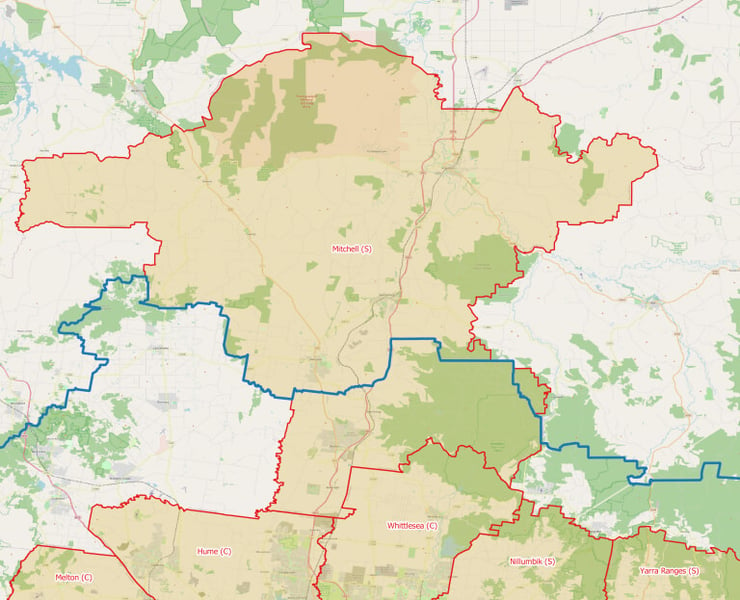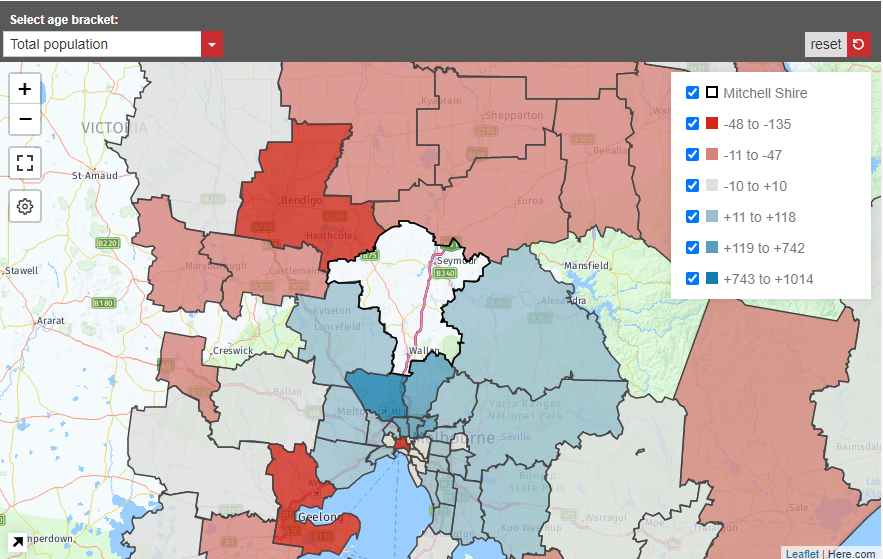While the inclusion of Mitchell Shire in the lockdown of Melbourne may have seemed odd for many of us, Glenn shares a demographer’s view of the link between that Shire’s southern towns and the northern parts of ‘Metropolitan Melbourne’ that have seen the highest number of Covid-19 cases. It’s a terrific demonstration of how you can use the migration maps in the community profile for your area to understand the demographic (especially migration) links between places.
I’d bet that before about a week ago, few people in Australia knew of Mitchell Shire. Here at .id, we’ve been working with the council and providing our toolkit, including community profile and population forecast for many years. But this Local Government Area with a relatively small population, sitting to the north of Melbourne has hit the national limelight in the last week, as it’s been included in the return to Covid-19 movement restrictions associated with Victoria’s recent spike of cases.
When the media talks about Victoria’s lockdown, it’s always “Melbourne and Mitchell Shire”, so the Shire gets separately mentioned every time it’s announced, while the other 31 LGAs involved in the lockdown are all lumped under “Melbourne”.
Mitchell Shire is an interesting place. Straddling the Great Dividing Range, its southern outskirts include the towns of Wallan and Beveridge, just 35-40km north of Melbourne, and just beyond the edge of the urban area. These are high growth areas where young families move to seek affordable housing within commuting distance of the city. This area at the 2001 Census had a population of just over 5,000. By 2016 it had grown to 13,000, and the current estimate is over 16,000. The population of Wallan-Beveridge is relatively young, with lots of families, and is relatively more culturally diverse compared to Mitchell Shire (lower compared to Melbourne overall, but increasing).

In contrast, the northern parts of Mitchell Shire, including Seymour and Broadford, are 75km-100km from Melbourne and have much older, stable to declining populations. Seymour also features a high level of socio-economic disadvantage.
So why was Mitchell Shire put into lockdown along with Metropolitan Melbourne?
Ostensibly, this would just be based on the number of cases. At the time of lockdown, there were 7 known Covid-19 cases in Mitchell (at the time of writing this has risen to 12) – this is higher than any LGA in Regional Victoria, but much lower than most areas of Melbourne.
Note that the Wallan-Beveridge area, along with neighbouring Wandong IS actually considered part of Greater Melbourne by the ABS, and is included in this benchmark on all our profile.id sites (see the map above, south of the blue boundary is in the Melbourne GCCSA). In fact, Mitchell Shire has benchmarks to both Greater Melbourne and Regional Victoria as it includes parts of both. So the phrase “Melbourne and Mitchell Shire” may be superfluous if you only included the Wallan area inside. That’s certainly the view of Mitchell Shire’s mayor, as reported by the ABC. And it makes sense – being such a diverse Shire, with the south functioning as an outer suburban part of Melbourne, and the north as regional towns.
But the lockdowns have uniformly been applied at the local government level – Perhaps that’s easier to understand and enforce than postcode or suburb level restrictions – so all of Mitchell Shire gets included in this case.
Then why Mitchell Shire, not other peri-urban LGAs just beyond the urban fringe? Why not Moorabool, Greater Geelong, Baw Baw Shire or Murrindindi?
As I said, it may well have just been the case numbers. But there is also a good demographic reason why Mitchell (at least its southern parts) was singled out.
Population movements into Mitchell Shire
Migration within our larger cities tends to go in corridors. Families who have grown up in a part of the city, when the children leave home and it’s time to settle down, more often than not migrate outwards to buy the new house in the more affordable area on the urban fringe, of the corridor in which they grew up.
So in Melbourne’s south-east, there is movement from Monash out to Casey and Cardinia. In the west, from Maribyrnong and Hobsons Bay to Wyndham and Melton, and in the north, it’s from Hume and Whittlesea to the new frontier of southern Mitchell Shire.
You can see that clearly on our migration maps. Mitchell Shire doesn’t get a lot of migration directly from overseas, but in the 2011-2016 period, 65% of its 2,710 net movements from other parts of Australia came from the Cities of Hume and Whittlesea.

A lot of this movement is of young people, leaving the family home. What this means is that a large proportion of residents in that growth part of Mitchell Shire will have close family in Hume and Whittlesea. Both those areas have been hotspots in the most recent wave of the pandemic – the City of Hume, in particular, has had the largest number of Covid-19 cases in Victoria for some time (448 total cases since the start of the pandemic, at the time of writing). And it has been confirmed that family gatherings are the source of a lot of the new virus transmission.
So including the Wallan-Beveridge area in lockdown makes sense from this point of view, due to the likely family connections with these hotspot areas. Unfortunately, the rest of Mitchell gets brought along for the ride, due to the use of the LGA boundary, though it doesn’t have those connections.
The other peri-urban areas such as Moorabool and Baw Baw Shire do have similar migration corridor connections to outer Melbourne areas, eg. Melton City and Casey/Cardinia respectively. But up to now, those haven’t been as significant hotspots as Hume. It seems likely that if further restrictions happen on an LGA-by-LGA basis (rather than the whole state), these areas would be the logical ones to include next, to try to contain the spread.
In this way, demographics can help understand some of these decisions and hopefully, assist with containing the virus. Stay safe everyone and stay home!
During the pandemic, we are continuing to work from home while still providing service to our clients. If you need any assistance with .id’s online toolkit, don’t hesitate to contact us via demographics@id.com.au or contacting us through our website.











